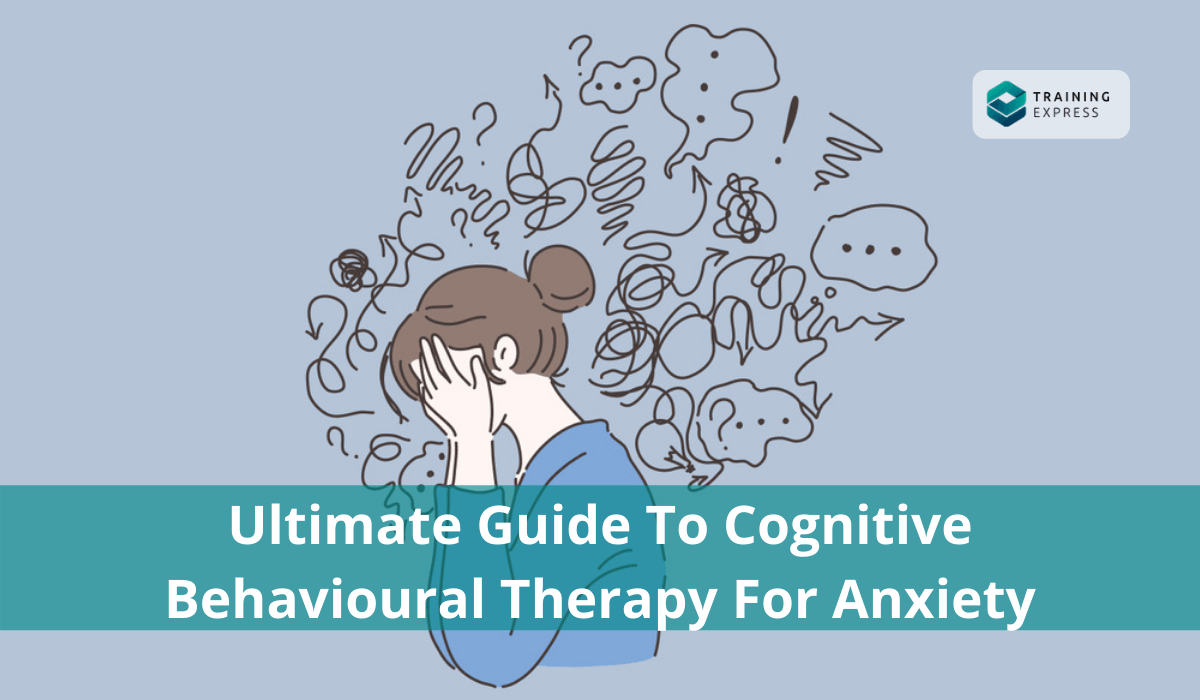
Everyone experiences anxiety to some extent, at some point in their life. But it doesn’t have to last a lifetime. You can control your thoughts and change your actions. You can change your life through cognitive behavioural therapy or CBT. Research proves that cognitive behavioural therapy for anxiety is a highly effective, evidence-based treatment.
In this blog, you will get answers to all your questions about cognitive behavioural therapy for anxiety to help yourself or your loved ones.
Table of Contents
What is Anxiety?
We all feel anxious from time to time. Still, anxiety disorders are more than a temporary bout of worry or fear. Anxiety refers to a feeling of unease. For instance, worry or fear, which can vary from mild or severe. Anxiety is feeling worried or anxious about an impending exam or having a medical test or for a job interview.
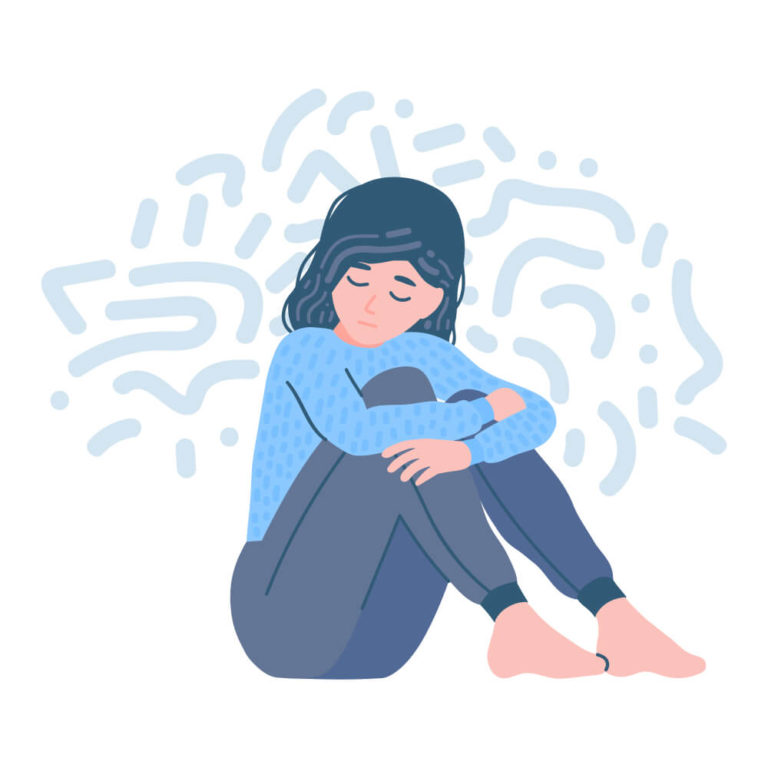
People with anxiety may exhibit fear that is intense enough to interfere with their day-to-day life. Not to mention, they can experience stress that may be out of proportion. For example, people with anxiety worry a lot and can’t put the negative thoughts aside. Besides, they may feel constantly tense and on-edge, even if they aren’t sure what exactly they’re anxious about.
Although depression is the condition most people associate with mental health issues, anxiety is more common. In fact, in a 2020 survey, 62% of respondents reported experiencing some degree of anxiety. And 284 million people worldwide suffer from anxiety disorders, according to a 2017 study.
Types of Anxiety Disorders
There are five significant kinds of anxiety disorders. So, it might be helpful to identify which one fits you. Also, it’ll help raise anxiety awareness, and you can get help accordingly.
1. Generalised Anxiety Disorder (GAD)
2. Obsessive-Compulsive Disorder (OCD)
3. Panic Disorder
4. Post Traumatic Stress Disorder (PTSD)
5. Social anxiety
Generalised Anxiety Disorder (GAD):
People with GAD constantly worry about everything and don’t know how to stop the worry cycle and feel it is beyond their control. Some characteristics of GAD are persistent and excessive worry about many things. Moreover, GAD causes people to feel anxious about many situations and issues rather than one specific event.
Obsessive-Compulsive Disorder (OCD):
It’s a disorder in which people have recurring, unwanted thoughts, ideas or sensations. And that make them feel driven to do something repetitively, otherwise known as compulsions. For example, double-checking or even triple-checking your locks before leaving home.
Panic Disorder:
A panic disorder can be characterised by repeated and unexpected panic attacks.
Post-Traumatic Stress Disorder (PTSD):
PTSD is a mental health condition triggered by a terrifying event. It can happen due to either experiencing it or witnessing it.
Social Anxiety (Social Anxiety Disorder):
Social anxiety disorder is sometimes referred to as a social phobia. It’s a type of anxiety disorder that causes extreme fear in social settings. People with this disorder struggle to talk to people, meet new people, and attend social gatherings. That’s because they fear that people will judge and scrutinise their actions and behaviours.
Besides these five major types of disorders, there are other anxiety disorders as well. They are below:
Health Anxiety:
Health anxiety is an obsessive and irrational worry about having a severe medical condition. It’s also called illness anxiety. In brief, it is a constant worry about having a severe illness.
Phobias:
It refers to an intense, irrational fear of something that poses little or no actual danger. For instance, fear of heights, crowded places, flying and so on.
What are the Most Common Symptoms of Anxiety?
Many people know what it is like to feel blue or sad or very worried about something. For some people, these feelings are big enough that they become challenging to manage by themselves especially when they fall into the vicious cycle of anxiety. Some common anxiety signs and symptoms may include the following:
- Feeling restless or worried
- Dizziness or heart palpitations
- Having a sense of impending dread or doom
- Trouble concentrating or sleeping
- Breathing difficulty (hyperventilation)
- Sweating or trembling
- Feeling very tired or weak
- Having trouble focusing on anything other than the present worry
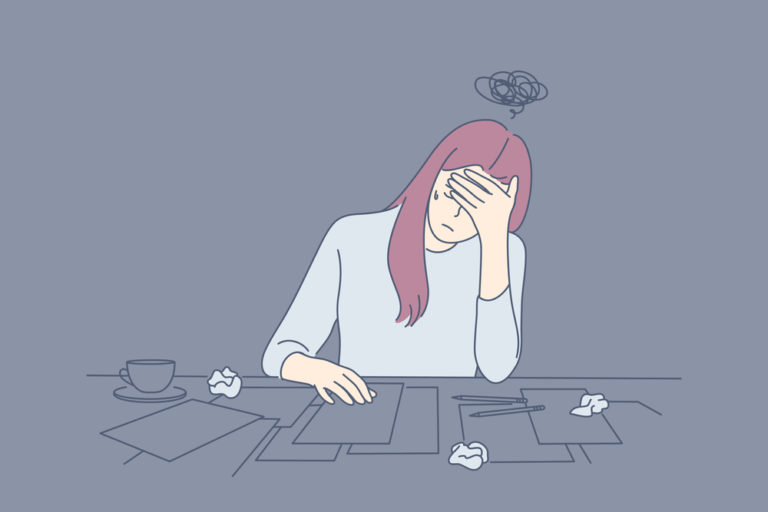
Note that there are other symptoms of anxiety too. These symptoms may vary depending on their type of anxiety disorders.
What is Cognitive Behaviour Therapy for Anxiety?
Cognitive behaviour therapy or CBT is a type of talk therapy or psychotherapy. Cognitive behavioural therapy is often called cognitive therapy. It is a type of treatment that focuses on how various factors within us and our environment interact to produce and maintain many issues. To clarify, these are the issues that people struggle with on a daily basis, such as anxiety and depression.
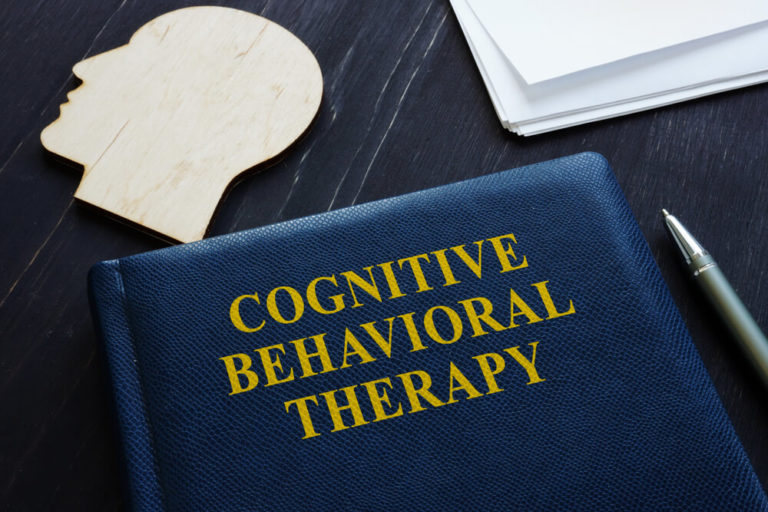
CBT uses many practical self-help strategies. These strategies are designed to improve your quality of life. Also, it can help you change unhelpful and unhealthy ways of thinking, feeling and behaviour. Correspondingly, CBT can be just as effective as medication to treat depression and anxiety. Because the CBT aims to help you identify and overcome harmful thoughts and learn practical self-help strategies.
The Four Components of Anxiety in CBT
In CBT therapy, we recognise four components (in addition to your environment) that act together to create and maintain anxiety.
1. Physiological
2. Cognitive
3. Behavioural
4. Emotional
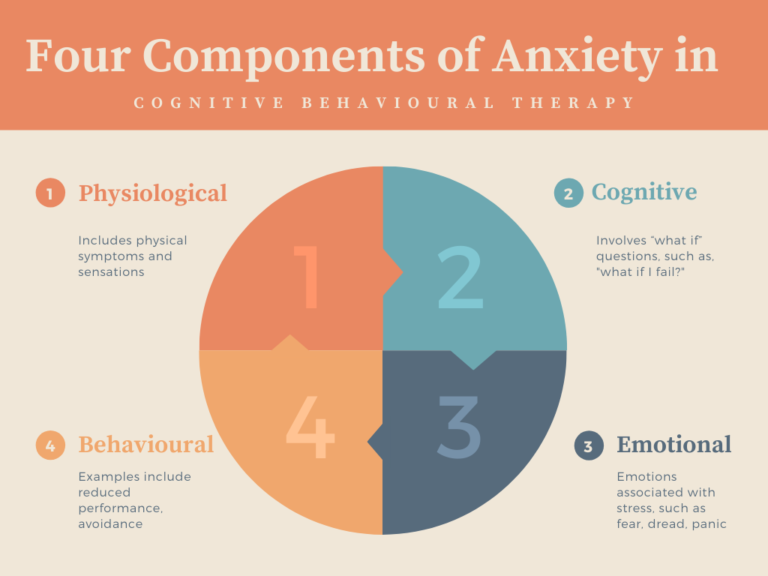
These four key components of cognitive behaviour therapy for anxiety are described below.
Physiological
The physiological component of anxiety involves specific physical symptoms and sensations. For instance:
- Accelerated heart rate
- Shortness of breath
- Tightness in the chest
- Feeling dizzy like you’re going to faint
- Weakness or tingling in your legs
- Muscle tension or headaches
- Lump in the throat
- Nausea or other bodily discomforts
- Feeling very hot, sweating and blushing
Cognitive
The cognitive component of anxiety involves “what if” questions. When thoughts and worries take the form of “what if…?”, they may correlate with the anxiety-provoking situations, such as-
- What if I fail?
- What if I embarrass myself?
- What if something terrible happens to me or my parents/spouse/children?
- What if I have a panic attack?
- What if I don’t fit in or if nobody likes me?
These “What if” questions can also associate with the physiological symptoms, as shown above.
Behavioural
The behavioural components of anxiety include reduced performance due to the anxiety. Suppose you’re focused on your worries or physiological symptoms. In that case, you may find yourself distracted and so concerned with what’s going on in your mind and your body. And you may feel removed from the outside world. As a result, things that would otherwise be simple, if it weren’t for your anxiety, such as a work-related task or socialising, become much more challenging to perform.
Another feature of behavioural anxiety is avoidance. Usually avoiding what you’re anxious about makes the fear subside in the short term. If you’re anxious about socialising or flying, or public speaking, or leaving the house, then avoiding those situations leads you can avoid feeling nervous for the time being. However, avoidance can wind up severely restricting what you can do and negatively affects your day-to-day life. When you try to or find yourself facing one of those situations, the anxiety returns more potent than ever.
Emotional
The emotional component of anxiety comprises emotions typically associated with stress, such as fear, dread, panic. Also, it can lead to other emotions such as frustration, anger, disappointment, sadness and depression.
The Vicious Cycle of Anxiety
According to the cognitive behavioural therapy (CBT) approach to anxiety, overcoming anxiety can be so tricky. Because anxiety generates a vicious cycle. This cycle of anxiety involves your physiological, cognitive, behavioural, and emotional domains.
In cognitive behavioural therapy (CBT) for anxiety, the vicious cycle may begin with an anxiety-provoking situation. And this situation can be something external such as a work commitment, a trip, a social engagement, or any other event happening in the future that you’re worried about. Furthermore, anxiety can be brought on by something internal such as a physiological sensation, thinking about something you’re dreading, or unpleasant emotion.
Can Cognitive Behavioural Therapy Help Anxiety?
Cognitive behavioural therapy (CBT) is one of the most widely-used therapy for anxiety disorders. Research has shown it to be effective in treating panic disorder, phobias, social anxiety disorder, and generalised anxiety disorder, among many other conditions. A study shows that CBT associates with improvements in quality of life in anxiety patients as well.
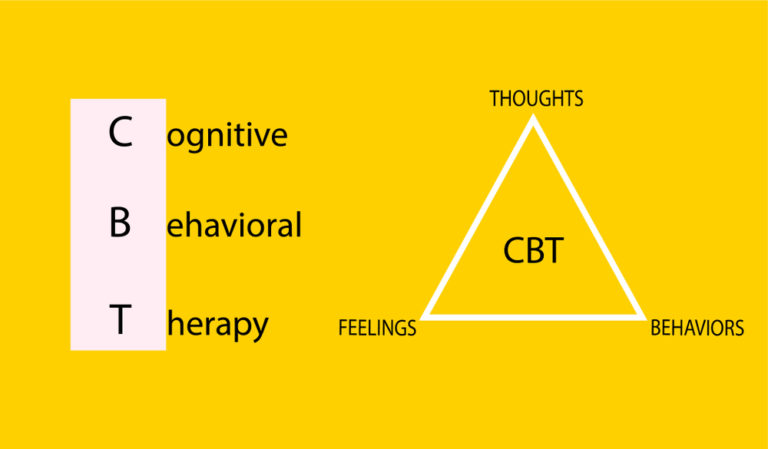
CBT can be a very useful tool to address your emotional challenges. For instance, it may help you:
- Manage symptoms of mental illness like anxiety
- Prevent a relapse of anxiety symptoms
- Treat anxiety without medications
- Learn techniques to cope with stressful life situations
- Identify different ways to manage emotions
- Help resolve relationship conflicts and learn better ways to communicate
- Learn to cope with grief or loss
- Help overcome emotional trauma related to abuse or violence
- Manage chronic physical symptoms
How Many CBT Sessions are Needed for Anxiety?
The National Institute for Health and Care Excellence (NICE) recommends 6 to 24 sessions for effective treatment. While some individuals may recover more quickly, some need more time to show good results with the treatment. In fact, these CBT sessions can be combined with additional therapies to ensure that underlying root causes of anxiety are tackled.
How Long Does it Take for CBT to be Effective?
CBT is highly effective psychotherapy (talk therapy). It is usually a short-term approach, so you wouldn’t be expected to continue with the treatment for a long time. In general, CBT is carried out in 1 to 1 session with a therapist. Similarly, it can be conducted in groups with other people who are in a similar situation to you.
Suppose you have CBT on an individual basis. In that case, you’ll usually meet with a CBT therapist for between 5 and 20 weekly or fortnightly sessions. Traditional CBT treatment typically requires weekly 30 to 60 minute sessions.
However, exposure therapy sessions may last longer to ensure your anxiety reduces during the session.

What is the Success Rate of CBT?
How effective is CBT for anxiety? Research shows that CBT is the most effective form of treatment for those coping with anxiety. Because, it is highly effective, with responder rates of 50–75%. That is only after 5 to 15 modules of CBT treatment.
Can CBT be Harmful?
Generally, CBT is not considered a risky therapy. However, you may feel emotionally uncomfortable at times. Because CBT can cause you to explore painful feelings, emotions and experiences.
What Techniques are used in Cognitive Behavioural Therapy For Anxiety?
Depending on the type of anxiety you’re dealing with, your therapist will help determine which CBT strategy best suits your needs. For instance, here are some of the techniques that are most often used in CBT:
- Cognitive restructuring or reframing.
- Guided discovery.
- Exposure therapy.
- Journaling and thought records.
- Activity scheduling and behaviour activation.
- Behavioural experiments.
- Relaxation and stress reduction techniques.
- Role-playing.
What Happens in a CBT Session?
In your first session, you may help the therapist understand the problem you’re dealing with and what you hope to achieve with CBT. Then the therapist may formulate a plan to achieve a specific objective. For instance, a SMART goal is depicted in the picture below.
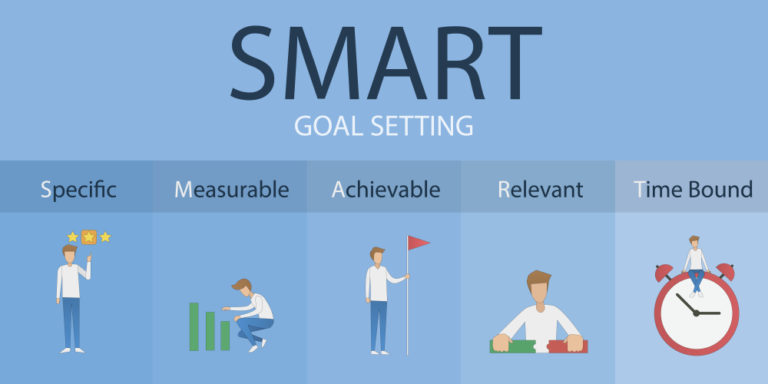
During a session, you may work through exercises with your therapist to explore your thoughts, feelings and behaviours. This can be in the form of diagrams or worksheets. With CBT, you are often given tasks to accomplish in your own time. So, at the end of each session, you may agree on some exercises to work on afterwards.
How can you Access Cognitive Behavioural Therapy for Anxiety?
You can get CBT treatment from the National Health Service (NHS). You may refer yourself directly to an NHS psychological therapies service (IAPT) without a referral from a GP. Or your GP can also refer you.
Look for a therapist who’s trained in CBT and has experience treating the specific issues you require. In like manner, you can check to make sure they’re properly certified and licensed. Your CBT therapist can be a healthcare professional who has been specially trained in CBT, such as a psychiatrist, psychologist, mental health nurse or GP.
Your therapy sessions may take place:
- In a clinic
- Outside – if you have specific fears, there
- In your own home/online, for instance, if you have agoraphobia.
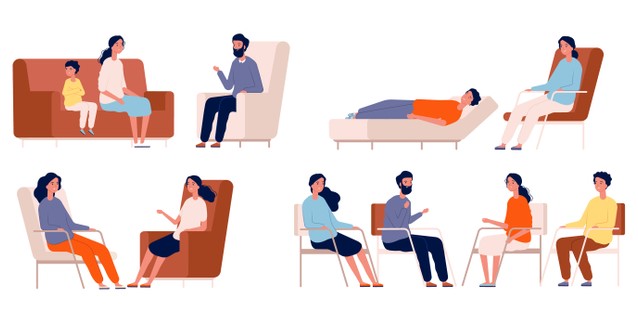
These sessions might be delivered:
- Individually – One on one sessions with a therapist. It can be face-to-face, over the phone or a video call.
- In a group – Group sessions are a viable option, with other people who may face similar problems.
- Through self-help books – Your therapist may ask you to complete exercises from any specific self-help book.
- Through a computer – You may take computerised CBT (usually online) sessions if you prefer.
It is important to remember that anxiety can not be cured in a day. It takes time to show proper results. Even after the therapy ends, you should think of learning from CBT as a part of your lifestyle.
The Bottom Line
Living with anxiety is hard. But you don’t have to go through it by yourself. Because help is available. Cognitive behavioural therapy for anxiety is very effective. And it might just be what you need to relieve you from the clutch of anxiety. In essence, this short term treatment can help you lead a stress and anxiety-free, happier life.
Read more on our blog
- The Early Years Foundation Stage (EYFS)
- Sports First Aid | Everything You Need To Know
- Lots of Likes on Instagram: How You Can Quickly Increase Popularity
- Why You Should Use Photo Background Removers For Mobile Devices
- Maximizing ROI: 11 Strategies For Efficient Advertising Spend
- How to Keep Your Data Safe While Applying for Jobs: 6 Tips
- Take Mac Classes to Transform Your Design Profession
- Exploring the landscape of e-commerce hosting
- Personal Branding For Executives: 7 Tips For Maximum Impact
- Transformative Technologies in Senior Living Homes: A Glimpse into 2024
- Available Courses
- Career Bundles72
- Animal care5
- Law8
- Quality Licence Scheme Endorsed111
- Teaching13
- Teaching & Academics Primary27
- Accounting & Finance Primary30
- Training3
- Design9
- IT & Software44
- Healthcare126
- Marketing31
- Health and Safety402
- Construction48
- Electronics25
- Hospitality22
- Health and Social Care219
- Child Psychology37
- Management375
- Business Skills268
- First Aid70
- Employability264
- Safeguarding75
- Food Hygiene103
- Personal Development1277
 Food Hygiene
Food Hygiene Health & Safety
Health & Safety Safeguarding
Safeguarding First Aid
First Aid Business Skills
Business Skills Personal Development
Personal Development







